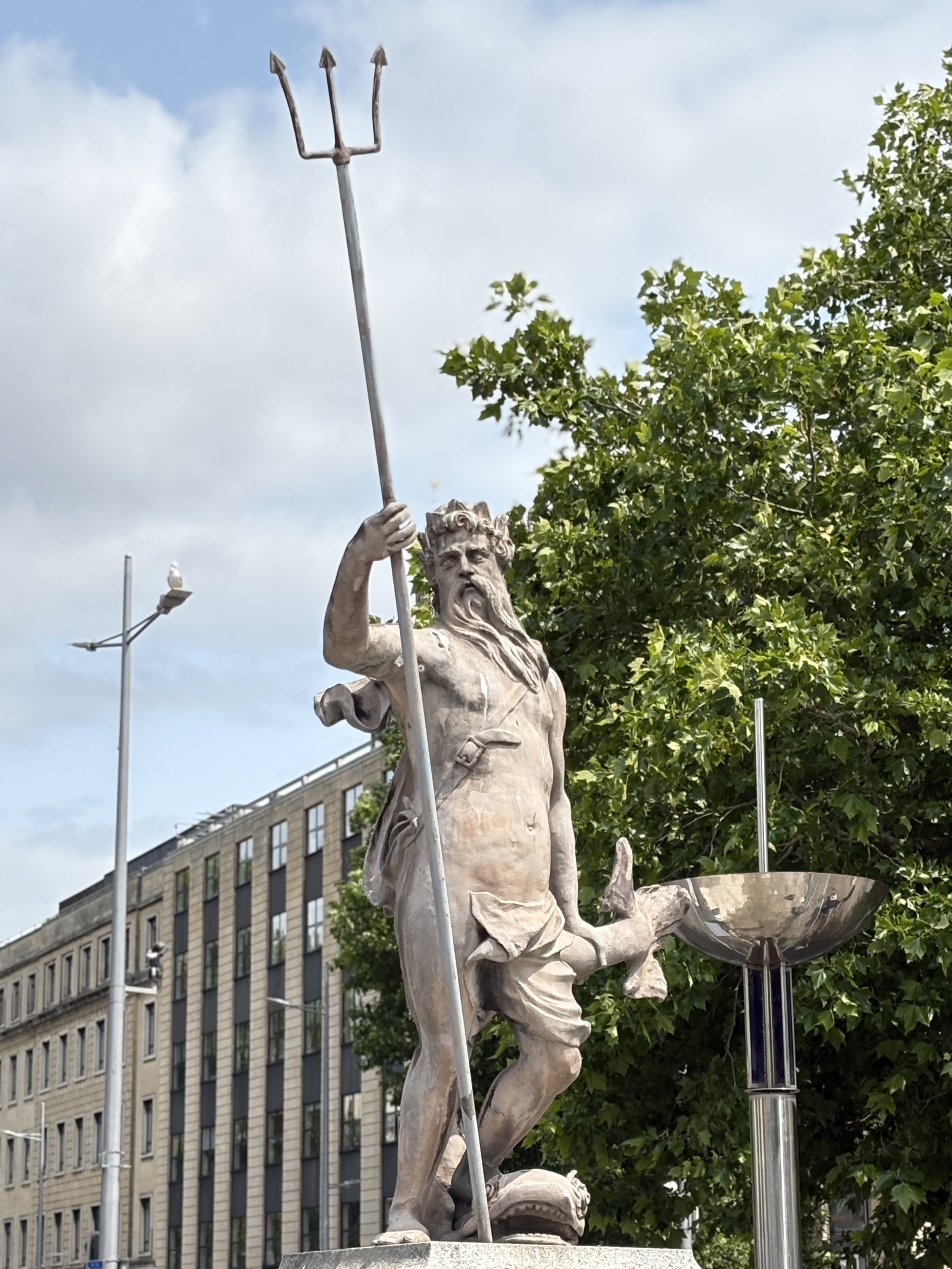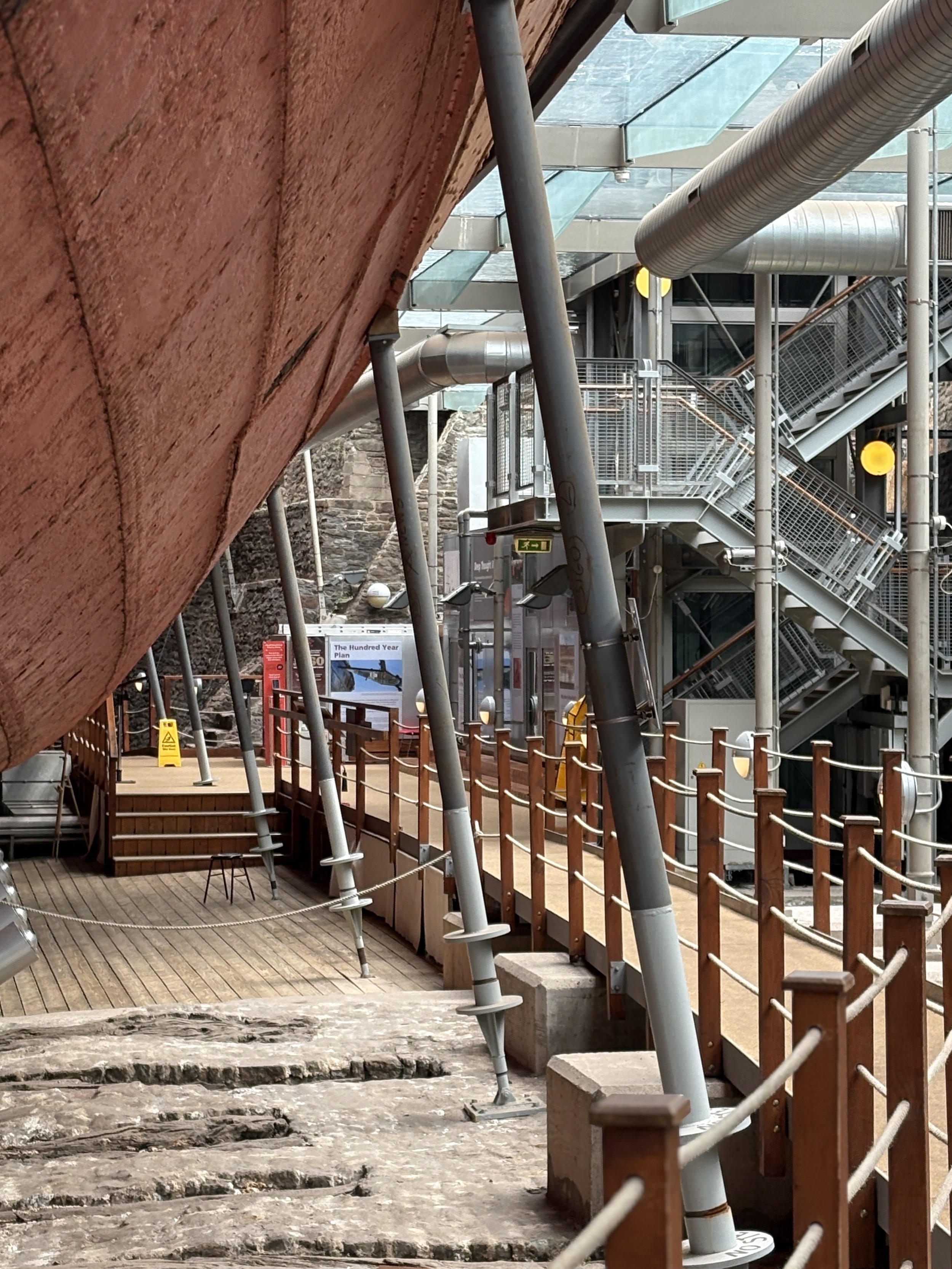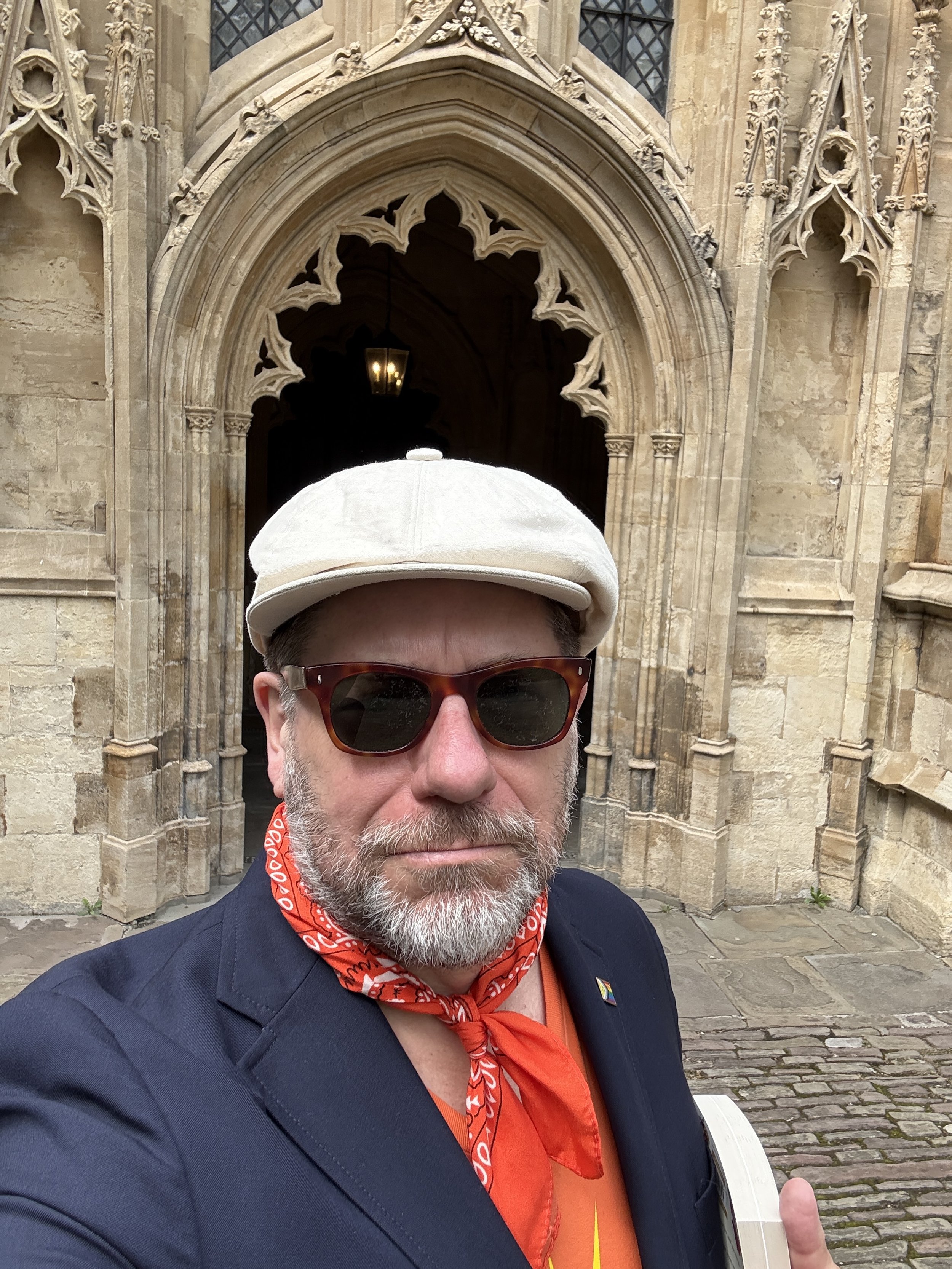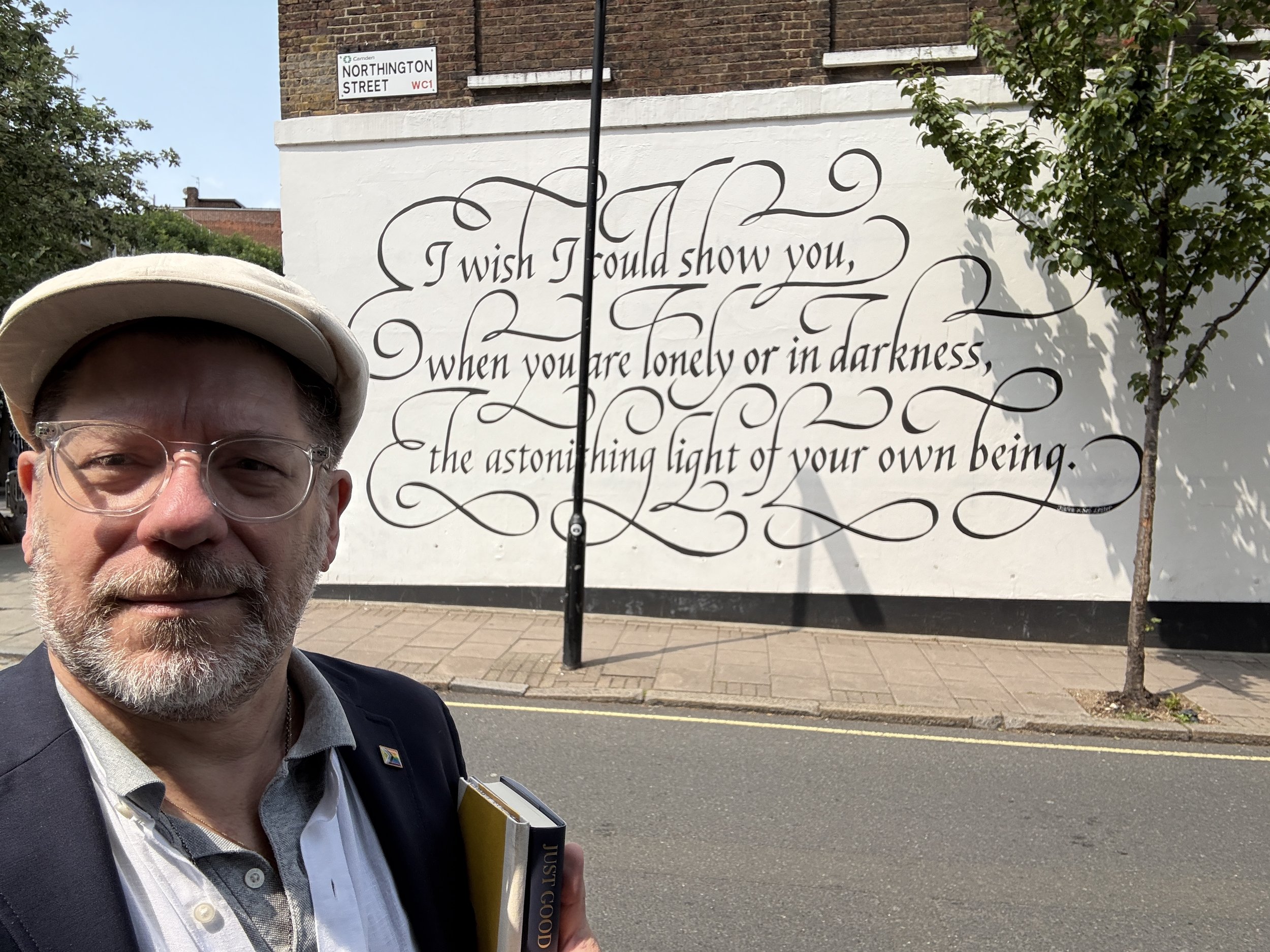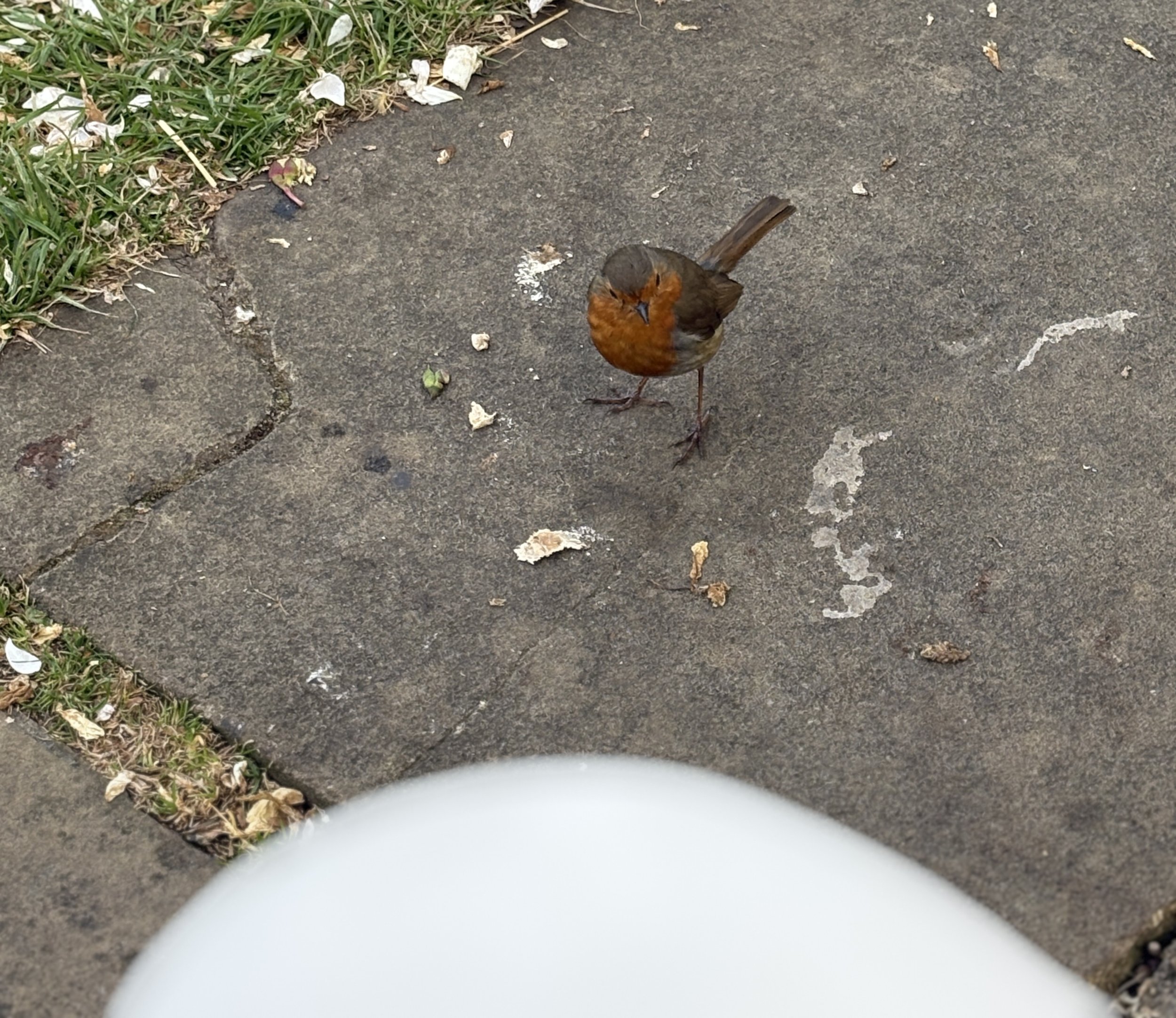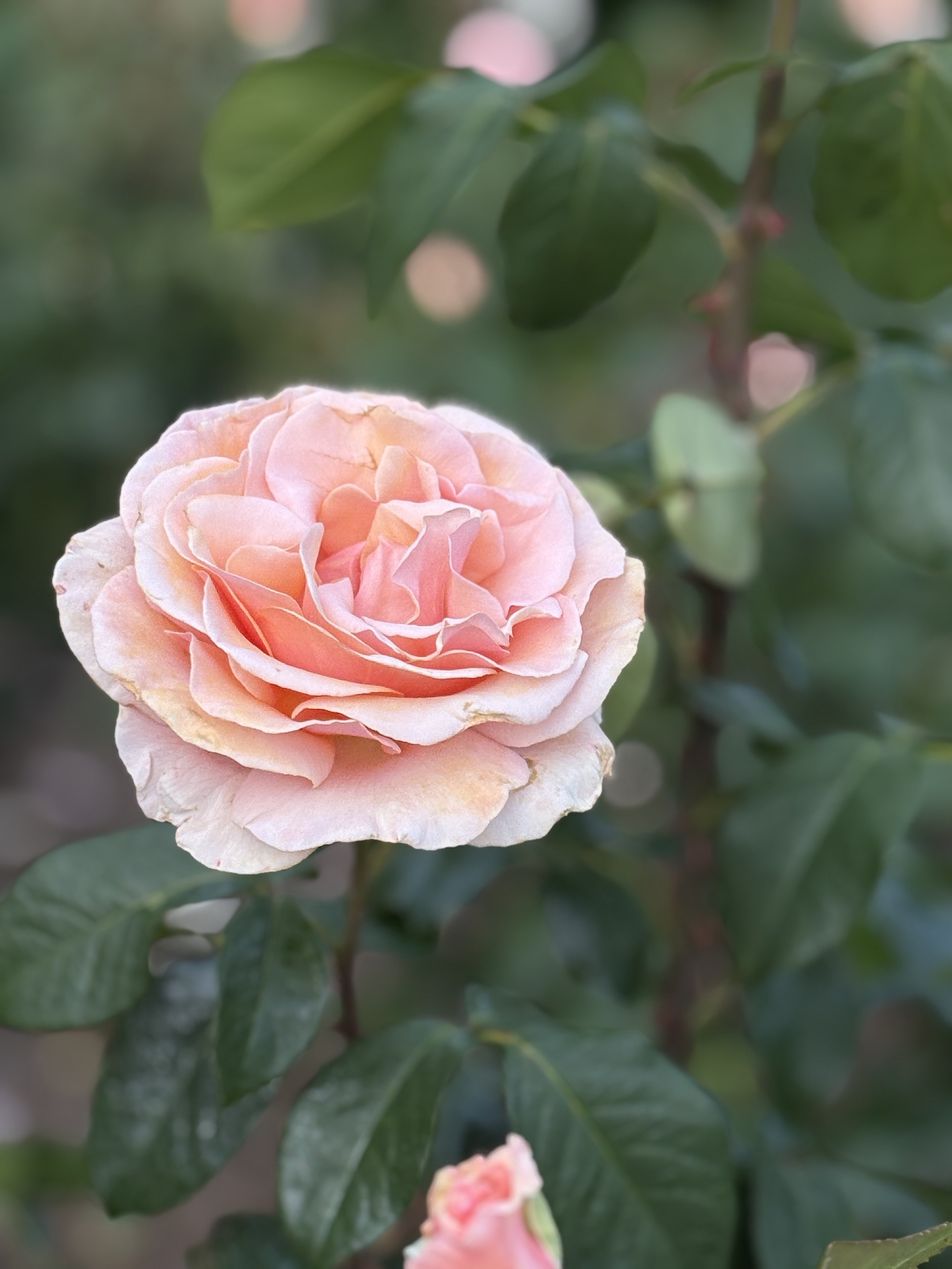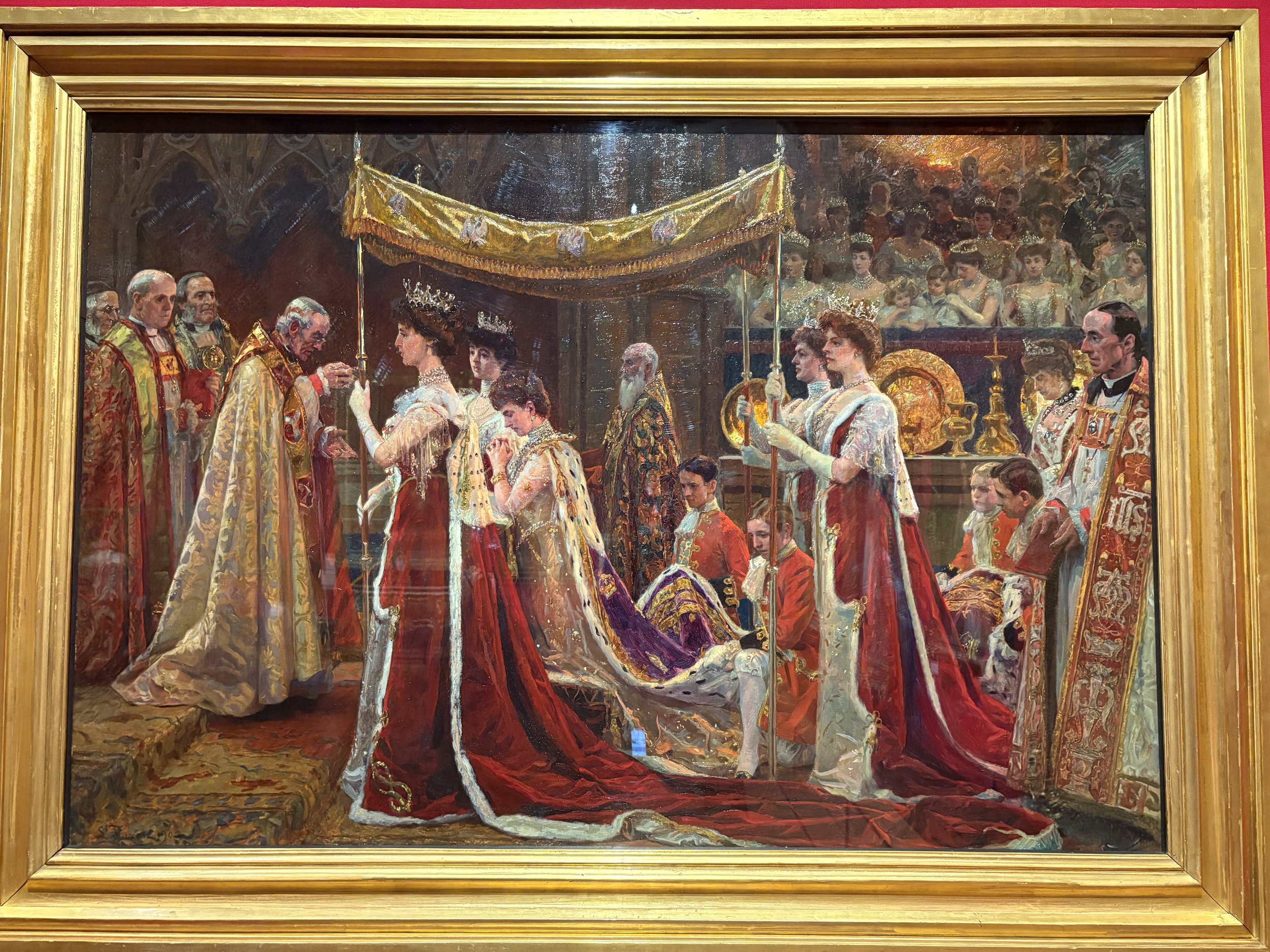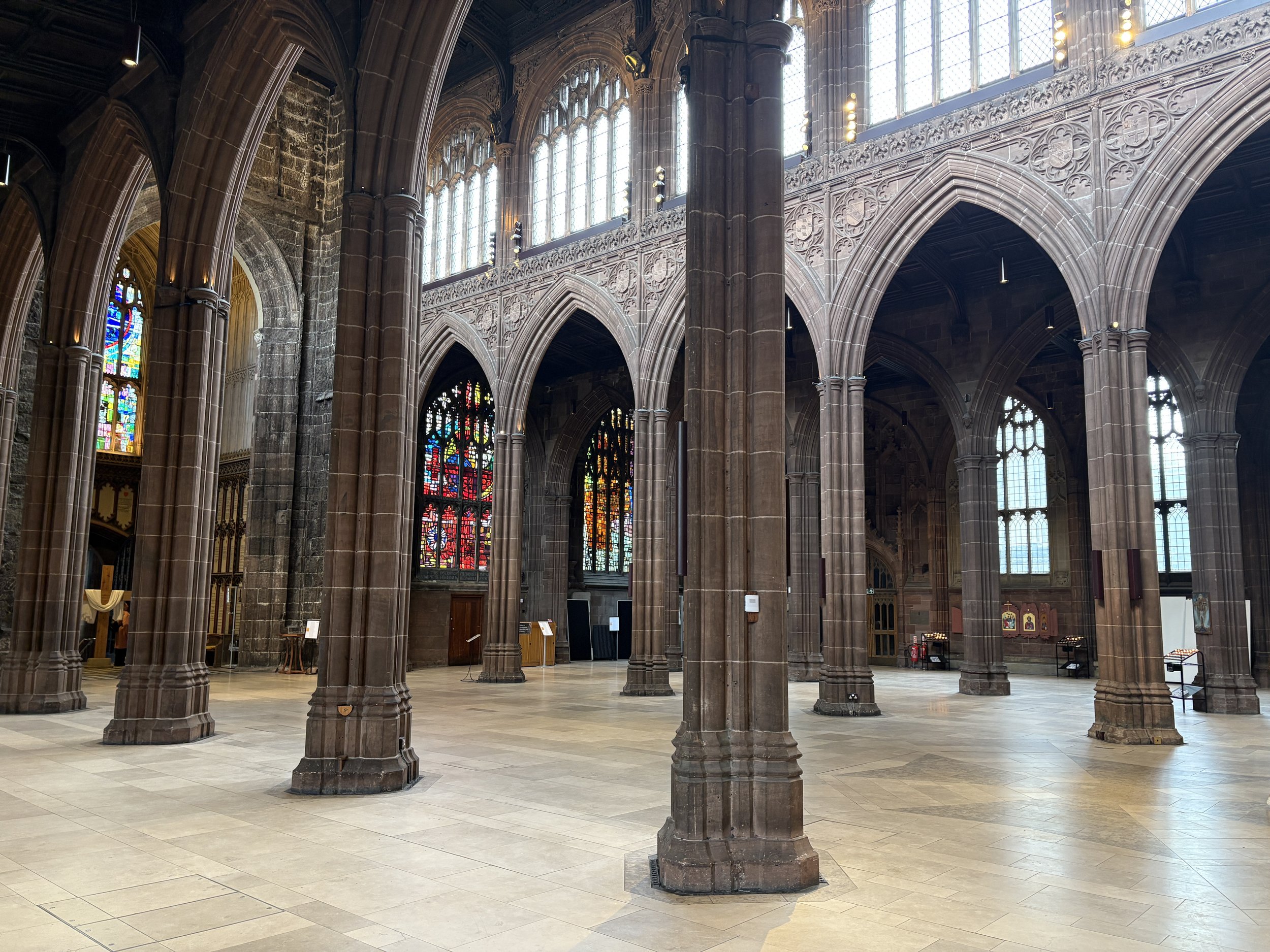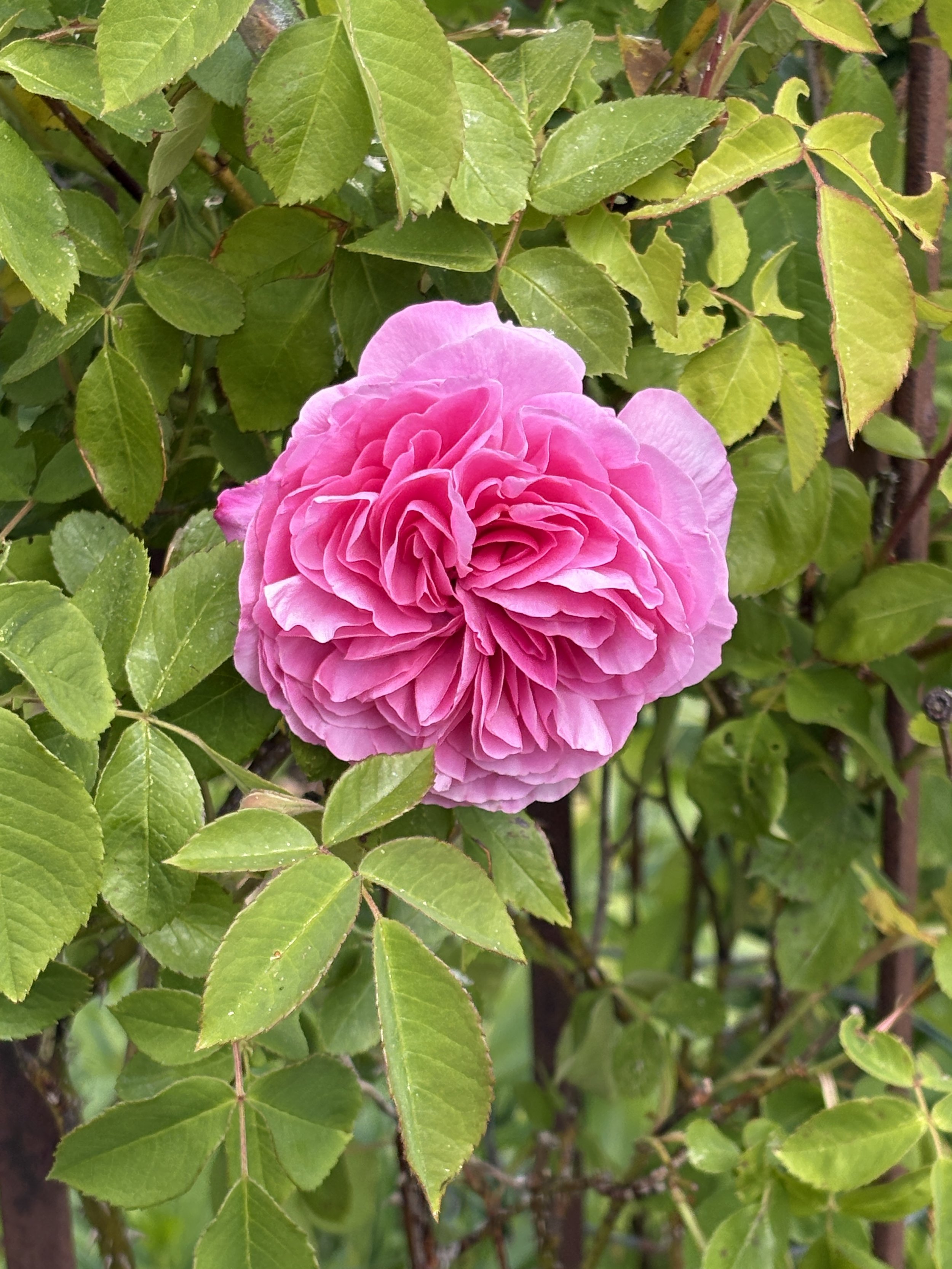“I must observe your country’s conduct has been uniformly wicked in the East, West Indies, and even on the coast of Guinea. The grand object of English navigators — indeed of all Christian navigators — is money, money, money . . .” — Ignatius Sancho to Jack Wingrave, 1778
Recollected three days later, waiting to board the train for Paris — and later in Paris.
1) My last two days in Bristol fell into a pattern: mornings at the hotel, breakfasting and writing; afternoons sightseeing, and evenings in my room. And that was OK.
2) Sometimes the best sleep comes half an hour before the alarm goes off. And Sunday, I let it go off twice. Finally, at 8:45, I started the day. SnoreLab proved I was asleep between 8-8:45.
3) After hotel breakfast, I returned to my room, put a few (but far from all) travel arrangements in place, responded to email messages, and finally set out for the day’s adventure.
Neptune and his Neptuning fork.
3a) One friend wrote to me that she admired my “commitment to solo travel . . . You travel so wonderfully and elegantly—as you do everything.” This made me glow a little, but what I don’t share is my strong preference for subways because of my fear of buses, my unhealthy reliance on Google Maps to get around, and especially my anxieties around where to eat and last-minute panic about travel documents. And in England, where driving is Opposite Land, I have to be doubly alert that I don’t wander into traffic and inadvertently end my life, or someone else’s.
3a.i) And also, now, the advance consideration of getting around with my hefty luggage. I’ve been so fortunate to have found a hotel where I can stash a bag as I gallivant hither and yon, but if I had to stagger up and down stairs in the Underground with all my luggage, I might inadvertently end my life, or someone else’s.
4) Today’s principal destination was the SS Great Britain, one of the many achievements of the brilliant engineer Isambard Kingdom Brunel. I left the hotel about noon and plotted my course to go by Bristol Cathedral, so I could really see it at leisure (not possible during evensong of course).
4a) And there is really a great deal to see at leisure, especially the church’s rich collection of stained glass of almost all periods. Of special interest to me were the World War II windows commemorating branches of the service, both men and women. (My photos of them were unworthy to share, alas.)
The Lady Chapel at the back.
5) But what absorbed my attention the most was a very thoughtful exhibition in the back of the church called All God’s Children, a deeply thoughtful and courageous “[exploration of] the Cathedral’s connection with the trade of enslaved people.” The city of Bristol, and the cathedral itself, were greatly enriched by the slave trade and industries it supported (like sugar), and the evidence survives in the form of memorials and church records of births, marriages, and deaths.
5a) This is a discussion that too many people in America are actively afraid to have, which is part of why we’re having our Current Moment. And indeed, it’s part of my own heritage thanks to great-great-grandfather Trotter, and the Terrills and the Lewises that came before him, and of course my distinguished cousin George Washington. My loving cousin Susan (may she rest in peace) had the courage to address so much of this, and she was taken from us too soon.
5b) I wish I could recollect more effectively everything I was thinking and feeling while going through this small, but great, exhibition.
Morris dancers!
6) Outside the cathedral, morris dancing! A quartet of Ladies of a Certain Age and two troupes of teenagers, the later quite adept dancing with their swords to the music of three violins and a recorder. They even formed the traditional star out of their swords, and then used it as a platform for one of the dancers to stand and be lifted on!
The ferry backs in.
7) As they began a waltz I continued on my way, guided by Gyygle Maps to the small ferry landing on the river. It operated on an “as needed” basis, so I guess when there was a quorum on either side of the river, the ferry would move. I didn’t have to wait long, and the trip across was less than two minutes on a gray but fresh day.
Here’s the bottom half of the SS Great Britain in climate-controlled drydock to preserve the iron hull from as much rust as possible. Cozy and warm! The glass ceiling is water. The flooring is the original 1830s drydock flooring.
8) The SS Great Britain, one of Isambard Kingdom Brunel’s great achievements, had four phases of its working life, and being preserved as an attraction and a relic of the 19th century is its fifth. It’s pretty astonishing! especially how they are preserving its iron hull.
8a) I got instructions on how to proceed from the ticket seller, the man who punched my ticket at the entrance, and then from a random woman employee sitting just outside the entrance — all of which felt conflicting. IF YOU GO, first go into the drydock to see the underside of the hull (which is fascinating, I admit), then go into the ship museum, weave your way through both floors of that, pop out onto the top deck of the ship, go back inside and downstairs, go around the bow of the ship, and then into the separate two-story exhibition Being Brunel, about Isambard Kingdom Brunel Himself.
8b) Who knew that his dining room was the Shakespeare Room in his house?! How fabulous is that?
8c) All of it was interesting, and interesting to see how they planned everything to be fun for children. Just as at the Titanic museum, you could pick up a card with a passenger’s name and facts on it (but all of them living), from when the Great Britain was transporting immigrants to Australia. At one point there was a slot machine game to determine how much risk went into any one of Mr. Brunel’s many ships, bridges, or railways.
Original crockery of the SS Great Britain.
8d) If they had had a reproduction coffee cup from the Great Britain’s crockery in the gift shop, I admit I’d’ve bought it. As it is, I feel lucky to have escaped with only one book, but this one about Queen Victoria’s table manners, The Greedy Queen.
8e) While in the shop I suddenly heard a spattering sound on the floor. A sweet but rambunctious little boy had accidentally scattered more than a few marbles, and I helped to gather up a couple.
9) From there I walked along the waterfront to my next destination, St. Mary Retcliffe, to which a friend had strongly suggested I go. I was certainly beginning to feel all the walking I’d done. And alas, when I got there, the church was closed. But a couple people came along, and I got to creep through the postern at the back of the sanctuary for a moment to see how really splendid it is. Ordinarily, the nice lady said, the church would be open. But after their big Rush Sunday service for Pentecost that morning, it was decided that everyone should go home and have a rest. And as a veteran of large events, how could I argue with that?
The church was closed!
10) By the time I got back to the hotel my lower back was really hurting, and I spent the evening trying to regain some equilibrium.
11) That turned out to be quite a challenge, as I was wakeful in the night with lower back pain, indigestion, and a phishing email that led to well over an hour with my phone/internet provider trying to find out if my account has been compromised. (I had to chat with five different people, one of them inexplicably from Sales. Diabolical inefficiency.)
11a) Moral: do not look at email in the middle of the night.
12) So I allowed myself to sleep in on Monday morning, and really got my best sleep between 8-8:45 AM.
13) A half-hour walk brought me back to St. Mary Retcliffe. This was a day to be conscious of posture — no not “Tonight, Agnes, you are Queen of Rumania!” posture, but consciously elongating the lower back and tucking in the tailbone to mitigate the soreness of the previous day. If Ai Weiwei had sculpted a hornet’s nest out of marble and then riddled it with serpentine carpenter bee tunnels that would cause it to fragment, well — that was my coccyx.
14) Now St. Mary Retcliffe was open, and I could understand what all the fuss was about. A truly lovely old church, so old it was priased by Elizabeth I as “The fairest, goodliest and most famous parish church in England.”
But then it was open on Monday! And look at this outstanding and unusual window.
14a) The first thing to fascinate me was a collage-style stained glass window, very beautiful, and modern to my eye, though the glass was obviously very old. I thought perhaps it had been assembled from windows blasted out during a WWII bombing. Well ha ha, wouldn’t you know it, the windows were all shattered during the Reformation!
Apparently these round doodads in the ceiling are called bosses. There are 1,200 here, no two alike, and the labyrinth one is famous.
14b) A very nice volunteer, a Gentleman Older Than I, welcomed me to the church, offered me a laminated floor plan and guide, and when he heard me speak, asked with a glint in his eye “Where are you from?” I made him guess, and first he said Canada, but then New England.
14c) No mere tourist attraction, St. Mary Retcliffe is an active community of faith, as evidenced by the small children’s area set up near the back of the church with soft seats and prefab shelves of books and playthings — quite a contrast to all the Very Old Things around it.
14d) They also had a little shop at the back, quite well done, but nothing that tempted me.
So many beautiful windows, but I will leave you with only this one.
15) To get to my next destination I retraced a few steps from earlier days, and found out that one of my favorite emojis had landed in Bristol. But I stopped only briefly, wended my way past the cathedral again, up the hill toward the museum, but turning left onto Great George Street to visit what is now known as the Georgian House Museum.
The dining room.
15a) Once the home of the Pinney family (which has sugar plantations in the Indies, and therefore built its family fortune on slavery), somehow it was bequeathed to the city of Bristol in the 1930s (?) which runs it as a museum free and open to the public. It’s been furnished to approximate what it looked like when the Pinneys lived there, including with some of their possessions, but also with period furniture from other Bristol properties. The Jovial Young Man at the entrance gave me a laminated guide and a brief introductory spiel, but I was allowed to proceed alone, at my own pace.
15b) Here and there I observed little white mouse dolls, including on the grandfather clock at the entrance. The Jovial Young Man explained that they were part of their kids trail through the house. An excellent idea, I suggested that the mouse mascot (mousecot?) be called Pinney.
15c) But the loveliest discovery was on the steps of the back garden, a vine of passion flowers. When I was a little boy our neighbors had a passion flower vine growing over our common fence, and they were the most beautiful flowers a boy could imagine.
16) The little bar at the corner was not yet open, and somehow I ended up in a nearby coffee shop called Restore for a Brie and bacon toastie and the most exquisite chocolate orange brownie. And that set me up just fine.
17) And wouldn’t you know it, there was a Banksy, right there!
18) By text Craig encouraged me to check out the St. Nicholas Market, which conveniently happened to be en route back to my hotel. The sort of bazaar Whaler’s Wharf in P’town used to be like (until it burned down, oopsie) with lots of crystals, jewelry, T-shirts and tie dye, Indian textiles and embroideries, secondhand books, and of course incense. My wandering led me into a little curiosity shop, two white-painted rooms full of books and games and ephemera. I acquired a book called Weird London: An Opinionated Guide and a couple card games for parties — along with a few laughs while talking with the Nice Man of Exactly my Age at the desk.
18a) I was forbidden to walk up an alley next to the market because — surprise! — they were filming a scene for something in it!
19) And so, back to the hotel, a negroni, and a fried chicken sandwich in the lobby for a quiet, exhausted evening of packing before my return to London next day.


